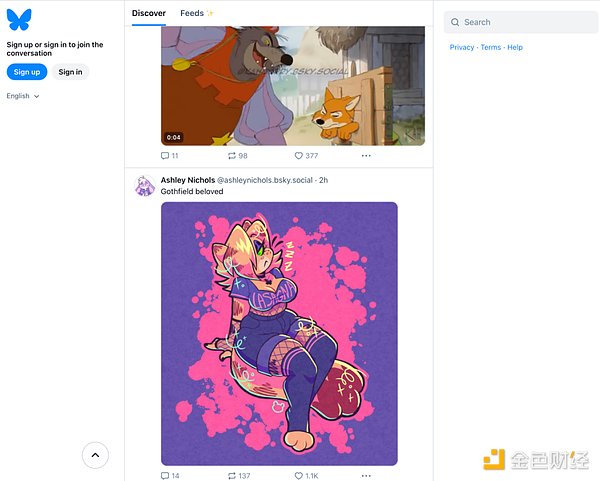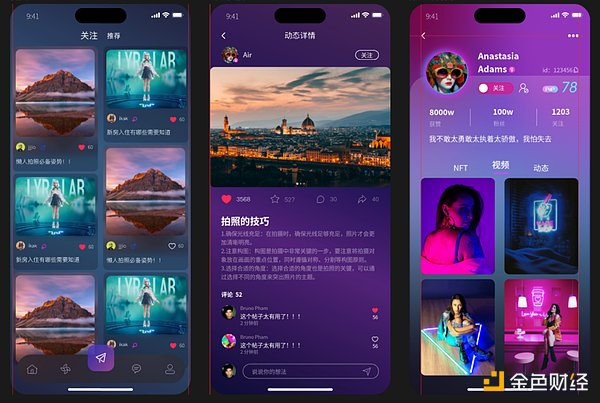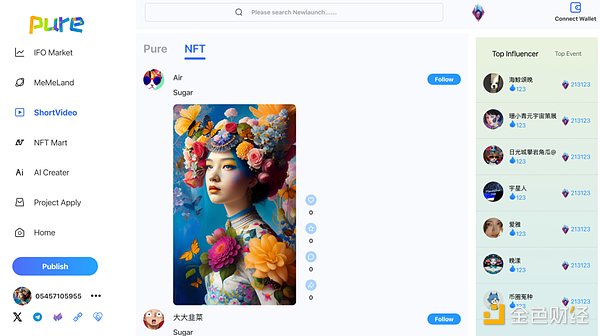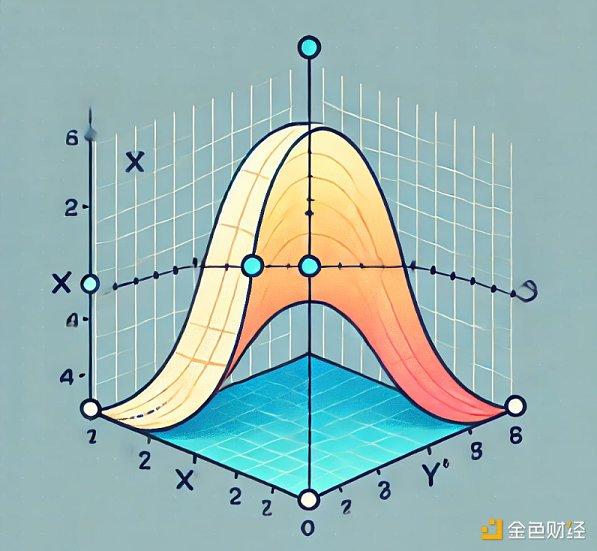Author: Revc, Jinse Finance
Preface
Bluesky recently completed a $15 million Series A financing round, led by Blockchain Capital, with participation from SevenX, True Ventures, and Alumni Ventures, among others. This funding will help Bluesky further develop its decentralized social experience and ensure that the platform does not become "over-financialized" through the use of cryptocurrencies, Non-Fungible Tokens (NFTs), or other blockchain technologies. Bluesky emphasizes that its goal is to create a social platform that is not controlled by a single company, in order to protect users' freedom of speech and data privacy.
After the decline of Friendtech, the social track is once again seeing large-scale financing. However, Bluesky's financing goal is to avoid "over-financialization". In contrast, Pumpfun, the most successful MEME token platform in Web3, is actively enhancing its social attributes, introducing features such as live streaming and video token issuance. On one side, there are PVP projects with sufficient cash flow and a financial focus, and on the other side, there is Bluesky, which is temporarily relying on VC funding. Bluesky leans left, Pumpfun leans right, who will be the future of SocialFi?
Bluesky
Bluesky is a decentralized social platform that aims to empower users with more freedom and control. Its user base has already exceeded 12 million, making it a strong competitor to Elon Musk's X platform. The latest data shows that Bluesky added more than 1 million new registered users in just 48 hours. This surge is partly due to changes in the privacy policy of the X platform, which allows third-party AI developers to use user data to train models, raising concerns among users about data privacy and transparency.
Furthermore, the X platform has recently adjusted its blocking function, weakening users' control over the visibility of content. This change has been widely criticized for potentially increasing the risk of online harassment. In contrast, Bluesky places more emphasis on users' autonomy over their social experience, allowing them to customize their information feed, choose the content and users they follow, and thus reduce information overload and unnecessary interference. This flexible design has greatly attracted new users to register and actively participate on the platform.

How Bluesky Achieves Decentralization and Autonomy
Decentralized Identifiers (DIDs)
The core principle of Bluesky is decentralization, where users own their own data and identity. Through Decentralized Identifiers (DIDs), users' data is protected on the network, avoiding the control of a single company over its content. DIDs allow users to freely migrate between different platforms, ensuring true account portability.
Personal Data Servers (PDS)
Users can choose to run their own Personal Data Servers (PDS) or use PDS hosted by others. This design not only enhances users' control over their own data, but also ensures the security and privacy of the data. User-generated content is cryptographically signed to ensure its authenticity and immutability.
Authentication Transfer Protocol (AT Protocol)
Bluesky is built on the Authentication Transfer Protocol (AT Protocol), a federated protocol for distributed social applications. The AT Protocol allows different servers to communicate with each other, ensuring that the various parts of the system can be run by multiple parties. This federated design allows Bluesky to fulfill its promise of "not being controlled by a single organization".
The AT Protocol was designed with scalability in mind, allowing the system to maintain high efficiency even as the user base grows. It distributes the load to participants who can handle it, reducing the reliance on a single server. This design enables Bluesky to maintain stable service quality even as the number of users grows rapidly.
Financialization
Currently, Bluesky's design advantages may only be activated in specific market environments, such as when freedom of speech is threatened or privacy breaches cause panic. However, such demand is relatively extreme, similar to the "ghost town" phenomenon of some Ethereum-based protocols. From a product perspective, Bluesky has not yet reached the level of basic functionality and UI of Web2 platforms. How do you evaluate Bluesky's non-financialization strategy? Is its future prospect a cause for concern? The relatively mature SocialFi products are currently developing along two paths:
1. CreatFi (niche Non-Fungible Token (NFT) artists or topic communities) - NFT - Bonding Curve (Friendtech) - SocialFi
2. Pumpfun - MEME - Bonding Curve (Friendtech) - SocialFi
The first path is primarily non-financial, but it is clearly lagging behind and currently relies on VC funding to maintain operations. Due to the lack of widespread adoption of Web3, an effective balance between expenditure and revenue has not yet been found to support the project's operation. As Pumpfun increases its investment in social content (such as live streaming and video token issuance), it is likely to establish its position as a leading Web3 social protocol. Therefore, in the current Web3 environment, the financialization of projects is an undeniable strategy, and Bluesky's differentiated advantages in the broader Web2 and Web3 integration North American market may still need time to emerge.
Without discussing Farcaster, its current advantage lies in maintaining a small Web3 elite community, lacking the social cultural genes for broader adoption. Farcaster's paid access design is more conducive to establishing a stable, non-FOMO discussion atmosphere in the early stages of the community.
Wandering Thoughts
As Joel John of Decentralised.co said, "If you step back and look at the bigger picture, you'll find that the basic elements we need to build the future already exist right now."
The core advantage of Web3 social lies in its decentralized architecture, which enables fast, low-cost, and bidirectional micro-value transfers, thereby improving the efficiency and fairness of value exchange and empowering every entity in the social network, including creators.
New social experiences drive user migration - "When we study the essence of social networks, we find that the existing networks have not been replaced by better alternatives. They have been disrupted by functionally similar but vastly different experiences. TikTok is not a better Instagram, nor a better Twitter or messaging tool. The future of Web3 social will likely not be a 'better Twitter', but rather build on the successful attributes of the industry, bringing speculative, verifiable ranking, and ownership." - Joel John, Decentralised.co
Can MEME and Non-Fungible Tokens (NFTs) constitute a new social experience? The answer is yes, as evidenced by the initial surge in trading volume. However, an overly strong financial attribute often leads to Ponzi-like or zero-sum dynamics, hindering the widespread adoption of Web3, resulting in a "sickle" that swings back at latecomers. Can this situation be changed? Possibly, but it will take time. First, let users have the opportunity to profit, and the landscape will gradually take shape.
The scale of social networks directly affects the innate motivations and behaviors of users. Has Pumpfun achieved economies of scale? Currently, it seems more like a PVP battle among existing crypto users, but beyond the massive fee income, Pumpfun may be exploring new product forms for Web3 social. Pumpfun now supports video token issuance - will it become the "Web3 version of TikTok"?
Does the image below spark your imagination? The feed page looks a bit outdated, but notice the NFT display area on the personal profile and the video token section on the left. Note: The image is from a certain Web3 social product.

While Web3 developers are still exploring the possibilities of feeds, tokenization, Non-Fungible Tokens (NFTs), and Friendtech, Pumpfun has directly combined video and MEME token issuance. Pumpfun may be a prototype of the future development of the SocialFi track, where all content forms and social relationships ultimately point to asset issuance.
Currently, Web3 is still struggling to achieve economies of scale, and the demand of a small portion of users is not enough to support large-scale adoption. The economic model for maintaining project operations is also designed for a small range of Web3 users, and the products cannot easily break free from their cognitive experience. There is a "generation gap" between Web3 and Web2 users: the early Web3 users were mainly Bitcoin miners, while now Web2 applications are targeting Gen Z, focusing on their interests in "egg parties and golden shovels".
Are most Web3 social projects in the Chinese-speaking area still active? What new explorations are there? Pure - Detiktok, a somewhat marginal example, is a decentralized creator platform.

The name "Pure" is derived from the meaning of "clear and clean". In the early stage of the TikTok explosion, content that teetered on the edge of propriety attracted attention, leading to a decline in human aesthetics. The diversification of modern cultural consumption patterns has given people more freedom of choice, but it has also caused people to lose their moral judgment standards for diverse consumption concepts under the domination of cultural consumerism and sensual desires, leading to confusion and disorientation in the choice of cultural consumption values, and even a certain degree of moral disorientation. Pure aims to change this situation.
However, the target users of Pure (Detiktok) have gradually withdrawn from the circle in 2021. Facing multiple market crashes and the impact of Ponzi schemes, Web3 has not been able to attract new traffic in the Chinese-speaking region, so most Web3 projects are still focused on building in the financial field.
Pure not only provides short video, AI creation and dynamic information flow functions, but also adds Friendtech and Non-Fungible Token functions. How can Non-Fungible Tokens be integrated into the information flow? The key is to display the Non-Fungible Token metadata through the API service provider. If the content can be converted into Non-Fungible Token assets and have the visualization and quantification capability of future cash flow value, then this incentive model can be feasible.
Pumpfun added short video and live streaming modules because short videos can greatly enhance the visual impact and emotional resonance in the process of MEME material dissemination, thereby triggering viral dissemination.
I once suggested that the founder of Pure write a financing Deck, and his response was quite Zen: "I often have many exciting ideas flashing through my mind, and it feels difficult to record them down, while writing a notice of discontinuation of operations is much easier. It is very difficult to form a warm emotional consensus with others on the understanding of the project or the track, and the operation mode of VC coins is very uncomfortable for me."
What should the information flow incentive be like in Web3 social?
The information flow is usually composed of creator content and advertisements. If Bonding Curve is the standard configuration of Web3 social 1.0, then "Parabola" may become a must-have option for social 2.0. Establishing an incentive mechanism for the social network based on the degree of creators' contribution to user usage time, the content before and after the advertisement segment in the user's information flow should receive the most incentives. At the same time, it is crucial to ensure the fairness of the information flow recommendation algorithm through AI.

Summary
Is the Web3 social singularity approaching? The charm of the current Web2 algorithm platform lies in the fact that it constantly introduces fresh content and accurately pushes it, firmly grasping the user. Pumpfun seems to have achieved this, but through financial means to stimulate the release of dopamine, and the user's motivation is to make a profit.
Bonding Curve is the main line of Web3 social products, which can cover the time cost of Web3 users and feedback their expected returns. On the optimistic side, the Web3 social singularity has arrived.
With the rise of the application layer chain tide, Web3 is expected to move further towards large-scale adoption. After the conceptual exploration of 0-1 in Europe and the United States, the Chinese-speaking region is expected to take over the construction of Web3. Generally speaking, the social atmosphere in Europe and the United States is more conducive to the emergence of novel product forms, but the Chinese-speaking region has unique advantages in operation and development iteration in the 1-10 stage, while the regulatory environment faced by the Chinese-speaking region still long-term constrains the development of the industry.








